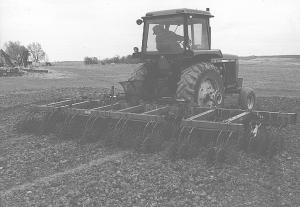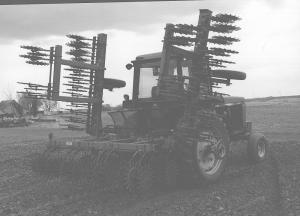1997 - Volume #21, Issue #4, Page #04
[ Sample Stories From This Issue | List of All Stories In This Issue | Print this story
| Read this issue]
"Double Toolbar" Rotary Hoe Controls Weeds In And Between The Row
 |
 |
"It has twice as much soil mixing action as a conventional rotary hoe, allowing me to eliminate weeds within the row as well as between rows without using herbicides," says Gebhart.
Gebhart farms organically, using no chemicals or commercial fertilizer. Once the crop is too tall for rotary hoeing he uses a cultivator to control weeds between rows.
He first converted his single toolbar rotary hoe to a folding model with a 10-ft. center section and 5-ft. wings. He then paid $110 for a used 15-ft. Deere rotary hoe and cut the toolbar into three sections - a 4-row center section and two 2-row sections. He mounted them 4 ft. behind the front toolbar. He left the hoe wheels on the front toolbar in their original position. The hoe wheels on back mount in groups of four spaced 30 in. apart, with the wheels in each group spaced 4 in. apart just like on front. The wheels on the back hoe are offset 2 in. to the left of the wheels on the front to more completely break up the soil.
A pair of depth gauge wheels mounts on the front toolbar to control depth of the front hoe wheels. Depth of the rear gangs is controlled by the top link on the 3-pt. hitch.
"It gives me the benefits of going over the field twice with just one pass," says Gebhart. "Rotary hoeing is a fast, cheap way to control weeds early in the season, so I of-ten make several passes. My double toolbar rotary hoe cuts the number of trips I make in half. I use it within 72 hours after planting and again every third or fourth day until the crop is big enough to cultivate. I cultivate corn once and soybeans twice. I also use the hoe in soybeans to break the crust in the rows before beans come up.
"One advantage is that my double toolbar rotary hoe has only half as many wheels on back so there's about 50% more downpressure per wheel, not including the weight of the extra toolbar and cross beams. The extra weight really helps in hard soil conditions.
"The original hoe has a 5 by 7-in. toolbar but the toolbar on back is only 4-in. square. However, I was still able to use the original U-bolts that were left over. I used the main frame off an old cultivator to make the cross beams."
For more information, contact: FARM SHOW Followup, Paul Gebhart, 2147 N. 1400 E. Rd., Edinburg, Ill. 62531 (ph 217 325-3250).

Click here to download page story appeared in.

Click here to read entire issue
To read the rest of this story, download this issue below or click here to register with your account number.




